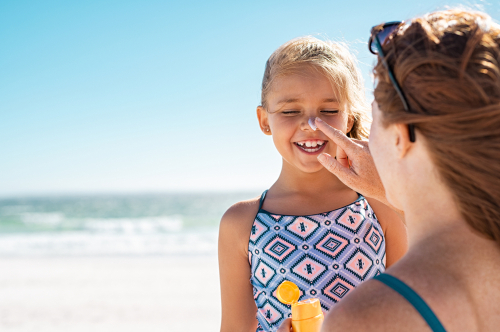
After spending so much time indoors during the past year, it probably feels like you've missed out on a lot of sunlight. And as summer kicks off, it's certainly tempting to make up for the lost time by spending extra hours outdoors.
But it's important to remember that your skin is just as susceptible to ultraviolet (UV) radiation as it ever was. UV radiation is the leading cause of skin cancers including melanoma, basal cell carcinoma, and squamous cell carcinoma. It can even cause eye damage such as cataracts and cosmetic problems like premature aging.
Below, CityMD Medical Director Dr. Janette Nesheiwat and Summit Health dermatologist Dr. Sam Kim outline all you need to know about UV exposure.
What is the UV index?
Dr. Nesheiwat describes the UV index as the "measurement of the strength of UV rays needed to produce a sunburn in a certain period of time." The lowest UV index is 0, when the sun is down and the moon is out. But during the day, the UV index can range from 1 (very low) to 11 or higher, which the AIM at Melanoma Foundation rates as "extreme."
Another way to think of the UV index is as a forecast for how strong the sun's rays will be on a given day says Dr. Kim. "It's meant to help us plan outdoor activities and decide what types of protection to use in order to avoid overexposure to harmful UV radiation. It's super easy to check on a daily basis—as easy as checking your weather app or simply by asking Siri, Alexa, or Google."
What affects UV exposure?
Various factors contribute to the level of exposure including:
- Time of day: The worst time to be outside in the sun is during the highest UV index, which is generally between 10 a.m. and 3 p.m. Both physicians note that even if you're wearing sunblock, you're still susceptible during this time.
- Season: The level is usually highest in the summer, but can also be elevated during other seasons, so it's important to always stay protected.
- Geography: You are more exposed to UV rays if you're closer to the equator or higher in elevation.
- Terrain: If you're in an environment that includes reflective surfaces such as water, snow, or sand, you're also more exposed to UV rays because light will bounce off and back onto you.
- Weather: Clouds can also play a role in scattering and reflecting UV rays. "Many of us may recall that some of the worst sunburns we have experienced occurred on cloudy days," Dr. Kim says. "Some UV rays (UVA rays) can penetrate glass, such as the window you sit next to at work or your car window. UVA rays can even penetrate rain and fog."
What are the benefits of some sunshine?
While it's important to protect yourself, it's okay to get a little bit of sun. "Fifteen to 30 minutes is a great dose," says Dr. Nesheiwat. "It results in the production of vitamin D, which aids in so many body and immune functions, bone and teeth strength, and absorption of other vitamins and minerals like calcium."
That said, don't use vitamin D as an excuse to get a tan, cautions Dr. Kim. "Because UV rays from the sun and tanning beds can cause skin cancer, the American Academy of Dermatology doesn't recommend getting vitamin D from extra sun exposure or indoor tanning," he says. "It's preferable to obtain vitamin D from a healthy diet, including foods rich in vitamin D or supplements."
What are some ways to protect yourself?
When you are planning to spend some time in the sun, keep in mind the following:
- Drink plenty of water: "Number one, you must stay hydrated," says Dr. Nesheiwat. If water isn't refreshing enough, try sports drinks that contain electrolytes.
- Take it easy: "Seek shade and avoid strenuous activity, work, and exercise in extreme heat to avoid heatstroke, heat exhaustion, and heat cramps," advises Dr. Nesheiwat.
- Dress appropriately: Both physicians recommend that you wear protective clothing in the heat, along with wide-brimmed hats and sunglasses to physically block UV rays. "Look for clothing with a UPF label," adds Dr. Kim. Many companies now make shirts, swimwear, and other garments with a UV protection factor (UPF) value, which ranges from 15 to 50+.
- Always apply (and reapply) sunscreen: Before you go outside, slather on a broad-spectrum, water-resistant sunscreen with an SPF of 30 or higher. Reapply every two hours or after getting wet from water or sweat. Dr. Kim also advises "taking special care to protect the scalp, ears, neck, lips, and tops of feet."
